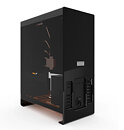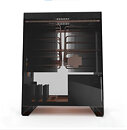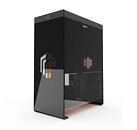Friday, September 25th 2020
MonsterLabo Announces The Beast
MonsterLabo, a maker of fanless PC cases, today announced its latest creation - The Beast. Featuring a design made from glass and 6 mm thick aluminium, the ATX case is resembling a design we usually could see only from the folks like InWin. The whole chassis is actually made up of two 3 KG aluminium heatsinks that feature ten 6 mm copper heat pipes each. All of this is used for heat dissipation and the case can accommodate up to 400 W of TDP in passive mode. When two 140 mm fans, running at 500 rpm, are added the case can cool more than 500 W of TDP. The Beast measures at 450 mm (L) x 380 mm (W) x 210 mm (H), making it for one large and heavy case. It supports graphics cards up to 290 mm in PCB length and is fully capable of supporting the latest NVIDIA GeForce RTX 30 series "Ampere" graphics cards. Pre-orders for The Beast are starting onOctober 9th, with an unknown pricing. You can expect it to be a high premium over 349 EUR price of The First case. Pre-orders will be shipping in Q1 2021.
Source:
FanlessTech



34 Comments on MonsterLabo Announces The Beast
Their descriptions are obscure, and their pics are dog doodoo.
Now that you've explained it, It seems to me that unless the case is perfectly made, that there could be an issue with ensuring perfect, constant pressure on at least the CPU. Even knocking a case could flex the contact enough to loosen it, right?
They already have heatpipes from the coldplates to each of the fin stacks, repeat by adding additional heatpipes from the fin-stacks to the side panels. No need to go around motherboard edge or anything like that, and they'd be short, cheap heatpipes as the side panels are almost in contact with the fin stacks anyway.
They also seem to have three very large >1cm heatpipes running front to back, I presume that's how they justify imbalanced load (250W + 150W) from two otherwise identical fin stacks. What's to stop them from bending those around the edge of the finstack to make contact with the side panels? That may be an even cheaper and easier solution, though it's possible the case needs those to contact the front and back panels for additional structural support.
As to the "easy part": as I tried to say in my first post addressing you, it's not easy at all. Going from the fin stack to the short front/back panels would be relatively easy, but those are easily half the surface area of the actual side panels (ignoring the necessary cutouts in the rear panel). Adding fins to the front would also be a rather ... bold aesthetic choice, definitely not one that fits MonsterLabo's choice of style (at least as demonstrated in their current two products). That of course ignores the inefficiency of thermal transfer from heat source -> heatpipe -> cooler fins -> heatpipe -> side panels, and the likely loss in air velocity inside of the chimney as some thermal energy is transferred outside. I don't doubt that this would increase the overall cooling capacity somewhat, I just don't think it would be worth it at all. That addition would likely be well past the point of diminishing returns for cooling, while significantly increasing cost and manufacturing complexity.
If you want to use the large side panels, given that these must be removable to enable component mounting, you're still left with the issue of how to attach heatpipes to a removable panel in a manner that is conducive to efficient thermal transfer. HDPlex and their peers solve this by having relatively flat cases with top panel access. That obviously isn't feasible here. Making one of the panels finned would likely be doable, but that would make assembly for the end user extremely complex as they would then need to remove the massive inner heatsink to mount the components (either CPU or GPU) between it and the finned panel, or you'd need to redesign the inner cooling system entirely. Access from the front/back panels or top would make connecting cables and connectors impossible, and leave no method for fastening components except for mounting screws on the outside of the panels.
What is likely stopping them from bending around the edge of the fin stack to make contact with the side panels is that this contact would be really, really poor. Heatpipes are very flexible, and mounting a removable panel like this without external screws would mean just pushing the side panel up against the pipes and hoping for the best. This ... wouldn't work. You don't get any kind of effective thermal transfer by just pushing a metal plate against a heatpipe. This would either necessitate smearing the side panel with tons of thermal paste (making disassembly a disgusting mess) or using thermal pads (which aren't very good, even the expensive ones). And contact pressure would still be really bad, further lowering thermal transfer. Unless the heatpipes are bent perfectly there would also be significant risk of only a small portion of the pipe actually touching the panel at all. This is of course ignoring the issue of aligning the loose end of a self-supporting heatpipe with a mounting point on a removable panel that you only have access to the opposite side of (I'm assuming the inside of the panel would have some sort of grooves for the pipes to sit in, like on the HDPlex cases).
So: what you are arguing for might improve cooling, whether marginally or noticeably, but it would also massively increase manufacturing and assembly complexity, and the increase in cooling capacity would never be that big. It would make this case a nightmare to build in - and that's starting from a case that already requires you to disassemble your GPU, so it's not like the barrier to entry here is low to begin with.
As for the unbalanced load ratings, I'm putting that down to the simple fact that GPUs are much easier to cool than CPUs, both due to their lower thermal density and their lack of an IHS. Cooling 250W more or less evenly spread across a 3-400mm2 bare die is a lot easier than if the same heat output came from 8-10 tiny hot spots (Intel's current 14nm cores are ~10mm2 each) on a 206mm² CPU die beneath a heatspreader.
I doubt that MonsterLabo would be getting more than 10w of cooling with a heatpipe from the fins to a side panel. Heat pipes lose their efficiency after 8” or so (on earth/under atmospheric pressure), and if they’re not actually making firm, level contact with the heat source, they are pretty much useless (for PC components).